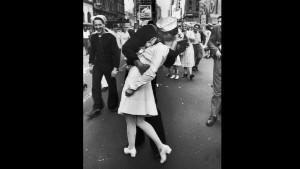Nurse kissed in iconic V-J Day photo dead at 92
Greta Friedman, the woman kissed by a sailor in the iconic picture taken in Times Square on V-J Day in 1945, has died, according to her son Joshua Friedman.
Friedman told CNN that his mother died at an assisted living home in Richmond, Virginia. She was 92.
The black-and-white photograph of Friedman, dressed in a white uniform, being embraced and kissed by a sailor to celebrate the end of World War II became an enduring image.
"My mom had so many stories and so many experiences; this was just one of many," Friedman said about the iconic photo.
![]()
![]()
Friedman, then 21 and a dental assistant, was in Times Square when the news of Japan's surrender to the United States was announced on a billboard, marking the end of the war.
"Suddenly, I was grabbed by a sailor," she told Veterans History Project in 2005. "It wasn't that much of a kiss. It was more of a jubilant act that he didn't have to go back."
The photo, taken by legendary photographer Alfred Eisenstaedt, was published in Life magazine a few weeks later. But the identities of the two people were a mystery.
It wasn't until 1980 when both Friedman and George Mendonsa, the sailor in the photo, were determined to be the couple in the photo.
"The reason he grabbed somebody dressed like a nurse, was that he felt so very grateful to the nurses who took care of the wounded," she told Veterans History Project.
News Courtesy: www.cnn.com











